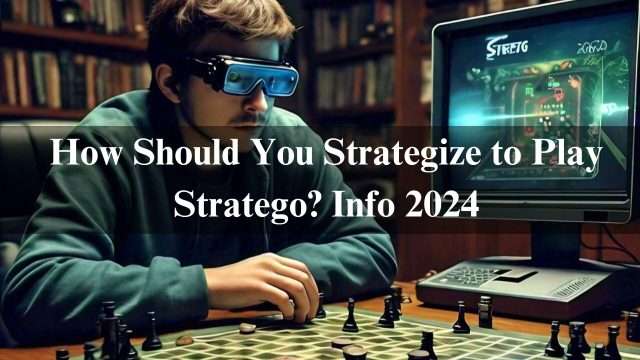Stratego is a classic strategy board game that combines tactical manoeuvring with deception and surprise. Its intriguing blend of strategy and chance captures the imagination of players who enjoy outwitting their opponents. In Stratego, each player commands an army of pieces with different ranks and abilities, aiming to capture the opponent’s flag while protecting their own.
To excel in Stratego, having a well-thought-out strategy is crucial. Success in the game doesn’t rely solely on luck; it demands careful planning, keen observation, and adaptive tactics. By developing a solid strategy, you can maximise your chances of victory and make every move count to outsmart your opponent.
Table of Contents
Understanding the Basics of Stratego
The objective of the Game
- The primary goal in Stratego is to capture your opponent’s flag or enough of their pieces to prevent them from making any further moves.
- Each player starts with 40 pieces that represent different ranks and abilities. Players must strategically move their pieces to achieve the objective while protecting their flag.
Basic Rules and Setup
- Setup: Each player arranges 40 pieces on the first four rows of their side of the board, keeping their setup hidden from their opponent. Strategic placement of pieces is crucial for both defence and offence.
- Movement: Most pieces can move one space per turn, horizontally or vertically. Scouts can move multiple spaces in a straight line.
- Attacks: A battle ensues when a piece moves onto a square occupied by an opponent’s piece. The piece with the higher rank wins and captures the opponent’s piece. If the pieces are of the same rank, both are removed from the board.
- Winning the Game: The game is won by capturing the opponent’s flag or eliminating enough of the opponent’s pieces to leave them unable to make a legal move.
Understanding these basics is the first step towards mastering Stratego. With this foundation, players can develop strategies and improve their gameplay.
Essential Strategies for Beginners
Piece Placement Strategies
- Frontline Defense
- Initial Setup: Place lower-ranked pieces and bombs in the front rows to create a defensive barrier. This prevents your higher-ranked pieces from being exposed early in the game.
- Decoy Strategy: Use Scouts and low-ranking pieces as decoys to draw out your opponent’s more vital pieces and gather information about their setup.
- Reserve Strong Pieces
- Backline Strongholds: Place your Marshal, General, and other high-ranking pieces towards the back of the board. This protects them from early attacks and allows you to use them strategically as the game progresses.
- Central Positioning: Position your vital pieces centrally to respond to threats on either flank quickly.
- Protecting the Flag: To create a secure zone, surround your flag with bombs and weaker pieces. Place Miners nearby to defuse any enemy bombs that may threaten your defence.
Common Beginner Mistakes to Avoid
- Overexposing Strong Pieces: Avoid moving your high-ranking pieces too early in the game, as this can make them vulnerable to capture.
- Neglecting Defense: Don’t focus solely on attacking; maintaining a solid defence is equally important to protect your flag and critical pieces.
- Predictable Moves: Avoid making moves that are too predictable. Vary your strategy to keep your opponent guessing and prevent them from anticipating your actions.
- Ignoring Scouts: Effectively utilise Scouts to gather information about your opponent’s setup. Ignoring this can leave you blind to potential threats.
Learning the Value of Each Piece
- Marshal (1): Use your most vital piece to eliminate high-ranking enemy pieces, but be cautious of the Spy.
- General (2): Second most robust; effective in taking out Colonels and below.
- Colonel (3) to Sergeant (7): These mid-ranked pieces should probe the enemy’s defences and capture weaker ones.
- Miner (8): Essential for defusing bombs; keep them protected until you need to clear a path to the flag.
- Scout (9): Vital for reconnaissance; use them to uncover your opponent’s setup and avoid traps.
- Spy (S): Can eliminate the Marshal if it strikes first; use it cautiously and protect it from being captured by other pieces.
- Bombs: Stationary but crucial for defence. Strategically place them to guard the flag and critical areas.
By understanding and implementing these essential strategies, beginners can enhance their gameplay, make more informed decisions, and increase their chances of winning in Stratego.
Advanced Tactics for Experienced Players
Bluffing and Deception Techniques
- Feign Weakness: Deliberately position weaker pieces in a way that suggests they are protecting valuable assets. This can lure your opponent into a false sense of security, leading them to make careless attacks.
- Misdirection: Move your pieces in a way that suggests you are planning an attack on one side of the board, only to shift your focus and attack from another direction. This can scatter your opponent’s defences and create openings.
- Double Bluff: Place your bombs in positions that seem too obvious, making your opponent think they are decoys. When they take the bait, they’ll fall into your trap.
- Piece Swapping: Regularly rotate and move your pieces to prevent your opponent from tracking specific pieces. This can create confusion and make it harder for them to plan effective attacks.
Utilising the Spy and Other Special Pieces Effectively
- Spy (S):
- Marshal Killer: Use the Spy to target the opponent’s Marshal, but only when you know its location. Keep the Spy hidden and protected until the right moment.
- Disguise: Place your Spy near lower-ranked pieces or positions where it might be mistaken for a Scout or Miner, keeping its true identity concealed until needed.
- Miner (8):
- Bomb Disposal: Always reserve a few Miners for mid-to-late game situations when you might need to defuse bombs protecting the opponent’s flag.
- Surprise Attacker: Use Miners to sneak behind enemy lines and clear bombs, allowing other pieces to advance.
- Scout (9):
- Reconnaissance: Use Scouts to uncover your opponent’s setup quickly. Don’t sacrifice them unnecessarily; their ability to gather information is crucial.
- Fast Attacks: Utilize their speed to capture unprotected pieces or to chase down fleeing enemy units.
Advanced Piece Movements and Attacks
- Pinning and Forking:
- Pinning: Use your pieces to pin down higher-ranking enemy pieces against a bomb or the board’s edge, restricting their movement and making them easier to capture.
- Forking: Position your pieces to threaten multiple targets simultaneously. This forces your opponent to choose which piece to save and which to sacrifice.
- Creating and Exploiting Gaps:
- Opening Gaps: Use your pieces to create openings in your opponent’s defences by forcing them to move key pieces out of position.
- Exploiting Gaps: Quickly move your high-ranking pieces through these gaps to capture valuable targets or to position yourself for a decisive strike.
- Sacrificial Plays:
- Sacrifice to Gain Position: Sometimes, sacrificing a lower-ranked piece can be beneficial if you gain a better position or capture a more valuable piece.
- Decoy Attacks: Use lower-ranked pieces to bait your opponent into attacking, revealing their piece’s rank and allowing you to plan a counterattack.
- Controlling the Center:
- Central Dominance: Control the centre of the board to give your pieces maximum mobility and flexibility. This allows you to respond quickly to threats on either side.
- Pressure Points: Apply pressure to key points on the board, forcing your opponent to react and potentially make mistakes.
By mastering these advanced tactics, experienced players can outwit their opponents, gain strategic advantages, and improve their overall success in Stratego.
What are common mistakes in Stratego?
In Stratego, players often make several common mistakes that can significantly impact their chances of winning. Here are some frequent pitfalls:
1. Poor Piece Placement
- Overconcentration: Placing too many high-ranking pieces in one area can leave other parts of your board vulnerable.
- Predictable Patterns: Using predictable patterns for piece placement can help your opponent anticipate your strategy.
2. Neglecting Defense
- Weak Defense: Failing to protect critical pieces like the flag or high-ranking officers can lead to quick defeats.
- Inadequate Coverage: Not having a balanced defence to cover various potential attack routes.
3. Over-Reliance on Specific Pieces
- Overusing High-Ranking Pieces: Relying too heavily on powerful pieces can make them easy targets if they are frequently exposed.
- Underusing Low-Ranking Pieces: Neglecting the strategic value of lower-ranked pieces and their potential to set traps or reveal enemy positions.
4. Lack of Adaptability
- You are sticking to a Single Strategy: Failing to adjust your tactics based on the evolving state of the game and your opponent’s moves.
- Ignoring Opponent’s Moves: Do not pay attention to your opponent’s piece movements and adjustments.
5. Revealing Too Much Too Soon
- Early Exposure: Revealing the identity of critical pieces too early in the game which can make them easy targets.
- Unintentional Reveals: Using pieces in a way that accidentally discloses their identity or role.
6. Inadequate Use of Terrain
- Ignoring Terrain Features: You should not leverage the board’s terrain (e.g., rivers, obstacles) to enhance your defensive and offensive positions.
- Inefficient Movement: Moving pieces in a way that doesn’t take advantage of the board’s layout.
7. Poor Resource Management
- Ineffective Sacrifices: Making poor decisions about which pieces to sacrifice, leading to unnecessary losses.
- Unbalanced Risk: Taking on too much risk with high-value pieces or failing to protect them adequately.
8. Failure to Plan Ahead
- Short-Term Focus: Concentrating on immediate gains without considering long-term implications.
- Lack of Strategy: Moving pieces with a clear plan or goal leads to disorganised and effective play.
9. Ignoring Opponent’s Strategy
- Not Analyzing Patterns: Failing to recognise patterns in your opponent’s play that could reveal their strategy.
- Underestimating Opponent: Disregard your opponent’s potential moves and tactics based on their piece placements and actions.
By being aware of these common mistakes and actively working to avoid them, you can enhance your strategic approach and improve your chances of success in Stratego.
New Trends and Strategies in 2024
Recent Trends in Competitive Stratego
- Increased Use of AI Analysis: Competitive players increasingly use AI tools to analyse their games and identify patterns in their strategies and those of their opponents.
- Hybrid Defensive-Offensive Setups: Instead of focusing solely on aggressive or defensive strategies, players are blending both approaches, creating setups that can quickly adapt to the game’s flow.
- Dynamic Bomb Placement: Bombs are being placed more unpredictably, often in the middle of the board or offensive positions, to surprise opponents and disrupt their plans.
- High-Risk, High-Reward Tactics: Players take more calculated risks, such as advancing Marshals and Generals early in the game, to create pressure and force errors from their opponents.
Insights from Recent Tournaments or Expert Players
- Adaptability: Top players emphasise the importance of adaptability, constantly adjusting strategies based on the opponent’s moves and the evolving game state.
- Mind Games: Psychological tactics are gaining prominence, with players using bluffs and deceptive moves to mislead and confuse their opponents.
- Focus on Endgame: There is a growing emphasis on mastering the endgame. Expert players suggest planning several moves to ensure a strong finish.
- Communication and Team Play: Effective communication and coordination are critical to the success of team tournaments.
How Modern Technology and Apps Can Help Improve Your Game
- AI and Machine Learning:
- Game Analysis: AI tools can analyse your past games, highlighting strengths and weaknesses and suggesting improvements.
- Opponent Analysis: Using AI to study and predict opponents’ strategies based on their previous games gives you a strategic edge.
- Training Apps:
- Stratego Apps: Various apps offer simulations and practice games against AI opponents of varying skill levels, allowing you to practice anytime.
- Puzzle Challenges: Apps with Stratego puzzles can help improve your problem-solving skills and tactical thinking.
- Online Communities and Forums:
- Strategy Discussions: Engage with other players in online forums to discuss strategies, share tips, and learn from experienced players.
- Game Reviews: Participate in game reviews and post-mortem analyses to gain insights from other players’ perspectives.
- Live Streaming and Tutorials:
- Twitch and YouTube: Follow live streams of top players and watch recorded games to learn advanced tactics and strategies.
- Instructional Videos: Tutorials and strategy guides on these platforms can help you understand complex concepts and improve your gameplay.
- Virtual Tournaments:
- Competitive Play: Participate in virtual tournaments to test your skills against various opponents and gain experience in a competitive environment.
- Global Exposure: Virtual tournaments provide opportunities to compete with players worldwide, broadening your experience and understanding of different play styles.
By staying updated on the latest trends and leveraging modern technology, players can continuously improve their skills, adapt to new strategies, and stay competitive in Stratego’s evolving landscape in 2024.
You can also read : Gang Beast Game Complete Review – Pros & Cons 2024
Conclusion
Recapping the key strategies and tips discussed, mastering Stratego begins with a solid understanding of the basics, including the game’s objectives, piece functions, and setup. For beginners, implementing effective piece placement, utilising frontline defences, reserving vital pieces, avoiding common mistakes, and learning each piece’s value is essential. As players advance, employing bluffing and deception techniques, strategically using the Spy and other unique pieces, and mastering advanced piece movements and attacks become crucial.
Staying informed about new trends in 2024, gaining insights from recent tournaments and expert players, and leveraging modern technology and apps can significantly improve gameplay. Consistent practice is vital, as is the willingness to experiment with different tactics and setups. Analysing each game, win or lose, provides valuable learning opportunities. We encourage you to share your strategies, tips, and experiences in the comments section below, fostering a community of learning and growth. By engaging with fellow players and continuously refining your skills, you can enhance your strategic thinking and become a more formidable Stratego player. Happy strategising!







